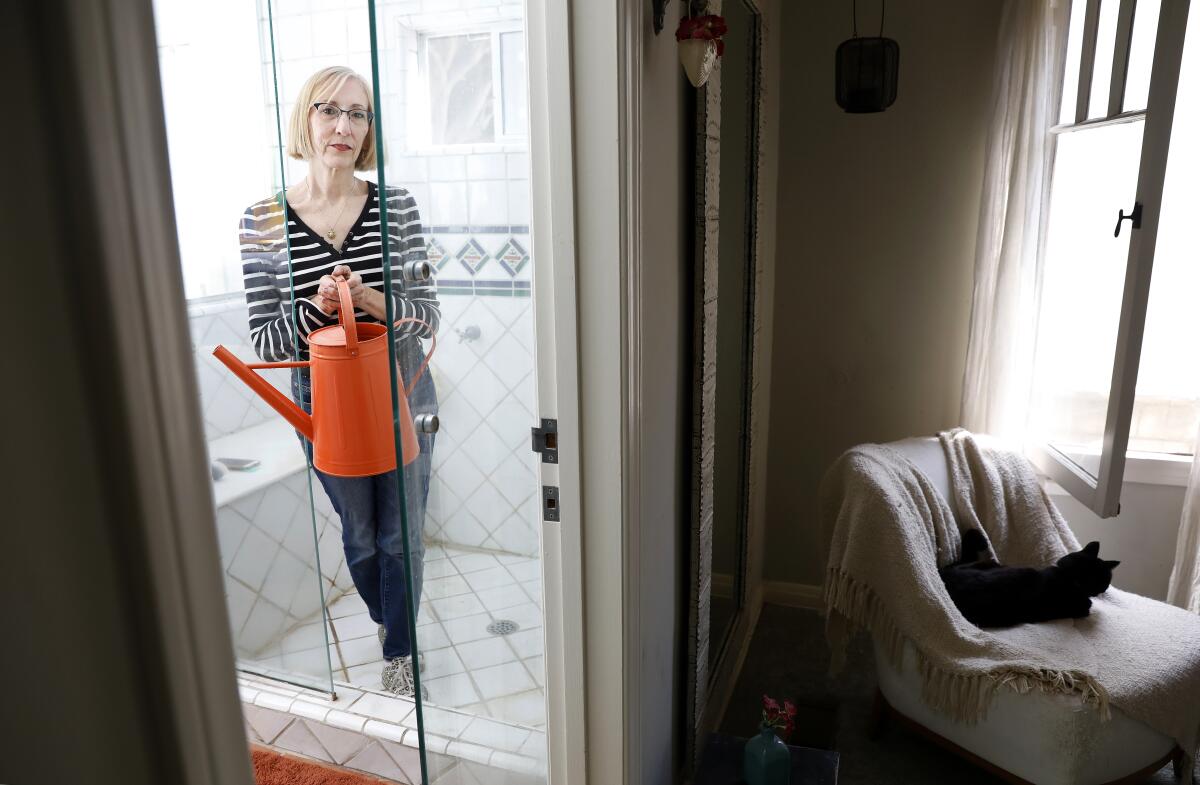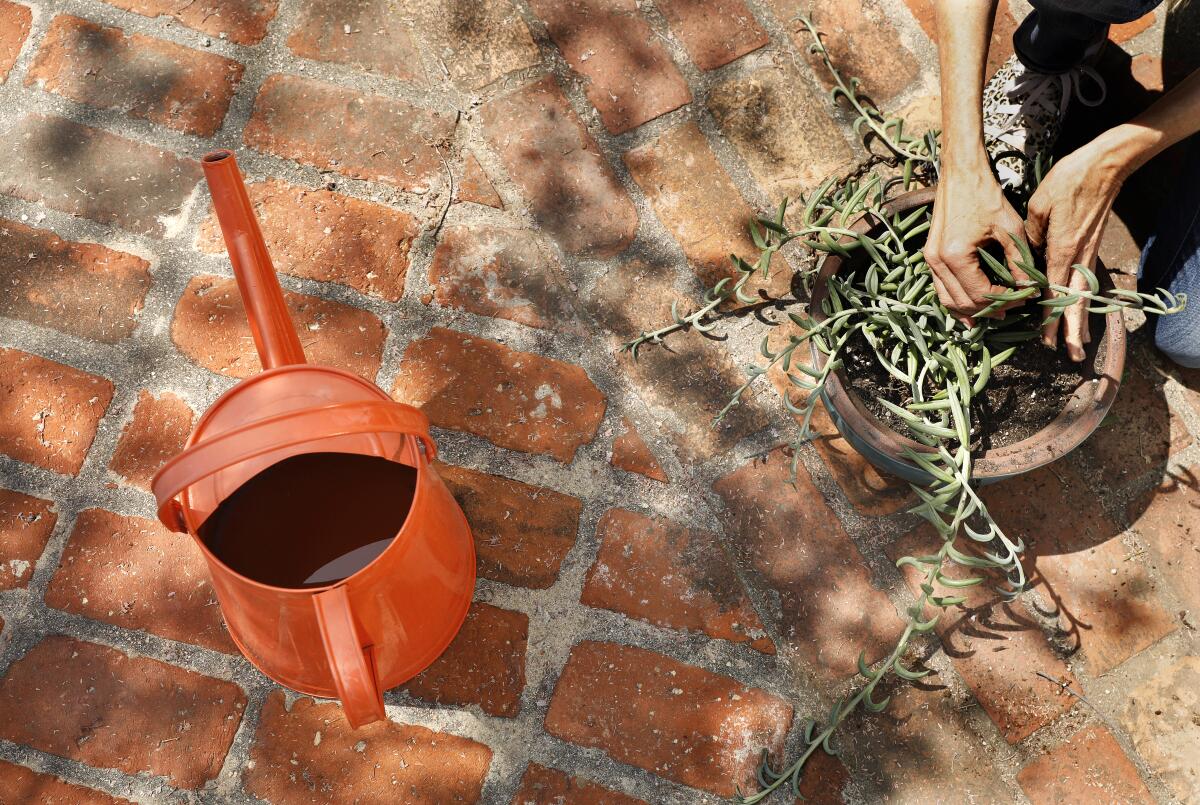What is the right length of time for the California drought shower?

On mornings that are chilly by Los Angeles standards, Camilo Loza sometimes takes a hot shower before heading to the gym.
After a workout on the Stairmaster, Loza bikes home to Windsor Hills and showers again. And a few nights a week, Loza takes a third shower after getting home from work.
California is now in the third year of a drought that ranks among the worst on record. But Loza says showering is an occasional indulgence in a studio apartment that has no lawn, no garden and no pool.
“My water use is pretty minimal, and mostly utilitarian,” said Loza, 32, who works in logistics for an heirloom food company. Loza previously worked as a line cook in restaurants and hotels, and left those jobs thinking that even modest water reductions at institutions and businesses “would have a far more profound effect than anything I could do at home.”
Driven by worsening drought conditions and reduced supplies from the complex system of reservoirs, canals and dams that supplies water to millions, the Metropolitan Water District issued its strictest-ever water cuts last month. Starting June 1, nearly 4 million customers in Los Angeles will face new restrictions on water use, with outdoor watering limited to two days per week.
Gov. Gavin Newsom told the state’s largest water suppliers last week that if conservation efforts don’t improve this summer, the state could be forced to impose mandatory restrictions. Water use in cities and towns across California rose by nearly 19% in March compared with 2020, according to state officials.
Showers aren’t in the crosshairs yet. But officials are encouraging Californians to save water wherever they can, including in the shower, one of the easiest places to waste — or conserve — a few gallons a day.
Which raises the question: Just what is the right length of time for a shower? Is it the national average of eight minutes, which the U.S. Environmental Protection Agency estimates uses more than a trillion gallons each year? Is it the so-called Navy shower — water on for 30 seconds, lather, rinse for a minute or so?
Or is it the Newsom model? The governor encouraged Californians last month to shorten their showers to five minutes and switch away from baths, which can use up to 2.5 times as much water.
That’s second nature to some Californians whose habits stuck after past droughts. Others are tinkering with their behaviors now, sticking egg timers to shower walls, installing lower-flow shower heads, or turning off the tap while they lather up.

Zan Dubin-Scott, who lives in Santa Monica, recently started putting a watering can in the shower to catch the water as it warms up.
The 2.1-gallon, terracotta-colored can doesn’t hold as much as the 5-gallon tubs that others recommend, but Dubin-Scott knows she can easily lift it and reuse the water on her potted plants.
“It’s about not letting the perfect be the enemy of the good,” Dubin-Scott said. “Imagine if every Californian stuck a pretty little watering can in their shower and saved 2.1 gallons every day.”
But losing or scaling back the relaxing, comforting solitude of a daily shower can be a tough sell, even in a drought. If a few extra gallons slip down the drain, some say, they’d still rather give up just about anything else first.
“In this hellscape that we’re living in, it’s the one joy I have left,” said Enia Titova, 40, a lawyer in San Francisco.
The shower is one of the few places Titova can ignore her phone and relax. The warm water soothes her aching joints. Sometimes, she does a little yoga. She’s rarely out in less than 20 minutes.
Titova said she leads a generally water-conscious life, in a small apartment without a yard, and with a diet light in meat, which has a large water footprint. So longer showers don’t worry her.
“Not to overextend the metaphor, but my shower is a drop in the bucket,” Titova said. “I would like to keep my showers for as long as humanly possible.”

About 80% of California’s water is used for agriculture, while the remaining 20% is used in homes, businesses, factories and institutions, said Heather Cooley, research director at the Pacific Institute, an Oakland nonprofit that focuses on water issues.
About two-thirds of the water in urban areas is for residential purposes, and that’s divided pretty evenly between indoor and outdoor use, she said.
One person’s shower habits won’t end the drought. But every Californian should still try to get into a water-conscious mind-set, she said.
“There’s always a bigger user out there,” Cooley said. “There’s always a crop that uses more water, or someone who owns more land, or someone with a bigger yard. The inevitable conclusion is that no one does anything. But what we really need is for everyone to do something.”
But “something” doesn’t have to be just taking a shorter shower, activists say. Californians can eat less meat, which is water-intensive to produce. They can install low-flow appliances. Or they can learn more about proposed infrastructure changes and legislation that will encourage better water use among major institutions and companies.
“It’s responsible for people to cut back on showers and carwashes and replace their lawns with xeriscaping,” said Jennifer Molidor, a senior food campaigner at the conservation group the Center for Biological Diversity. “But they should also build pressure against the biggest municipal users and the larger users overall.”
And then there’s the change that anyone can do, even a renter: switch out your shower head.
Showers account for about 17% of indoor water use across the U.S., according to federal data. That number is thought to be slightly lower in California, in part due to the country’s most stringent appliance standards.
California limits the water flow of shower heads sold in the state to 1.8 gallons per minute, a reduction of up to 28% from older models that can use up to 2.5 gallons per minute.
Swapping out an older shower head for a more efficient model is “a guaranteed way to save more water without having to think about it,” said Terrence McCarthy, a water resources policy manager at the Los Angeles Department of Water and Power.
The DWP is mailing free shower heads and faucet aerators to customers who request them.
The average daily water use for residential customers at the DWP, which includes everything from watering the lawn to drinking a glass, is 76 to 77 gallons, McCarthy said.
The utility has asked residential customers to reduce their daily water usage by seven gallons, about a 10% cut. Those savings could be achieved by cutting four minutes from a daily shower or by shutting off the tap during teeth-brushing and shaving, the utility said.
In previous droughts, the department recommended that residents try a “Navy” shower — lathering up with the tap turned off — and stick a bucket under the tap that can capture water as it heats up. That water, free of soap and any debris, can be reused to quench thirsty houseplants or yards.
Jean Rowley of Huntington Beach said her household already swapped out their shower heads for more-efficient models.
But in the last few years, she also scaled back her showering after reading media reports about the lack of rainfall and seeing the dry, parched hills while she drove on the freeway.
Rowley, a retired math teacher, has her routine down to a science: On day one, she does a full workout, then takes an eight- to 10-minute shower, including washing her hair. On Day 2, she rests. And on Day 3, she rides her exercise bike, then goes through a quick scrub-down without shampooing.
Scaling back her daily showers wasn’t a huge sacrifice, Rowley said, because she’s always viewed showering as “just something that’s on the list of things to do. I almost find it annoying.”
All the changes have given Rowley a sense of confidence, she said, that “when more draconian requirements come into play, I’ll be able to say, ‘Hey, I’m already doing that.’ ”
The idea of every customer being asked to reduce water usage by the same amount didn’t sit well with Howard Seth Cohen, a substitute teacher who lives in a one-bedroom apartment in Echo Park with his wife and two cats. Instead, he said, every customer should get the same allotment, regardless of where they live.
“If they’re going to ask us to limit usage, it should be fairly distributed,” Cohen said. “It shouldn’t matter that a person lives on a larger lot or has a yard. That person should not be allowed to use more of the water than an urban apartment dweller.”
More to Read
Sign up for Essential California
The most important California stories and recommendations in your inbox every morning.
You may occasionally receive promotional content from the Los Angeles Times.











